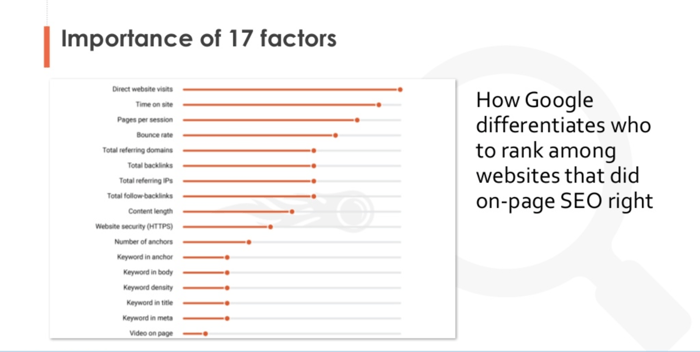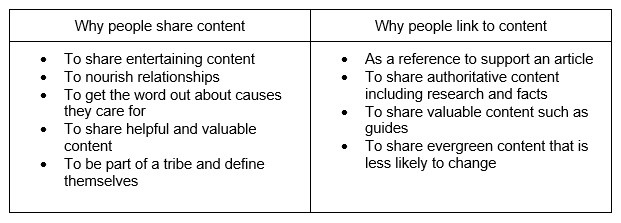Let me start by making one thing very clear: Guest posting is not PR.
Now that we know what guest posting isn’t, we can dig into what it is – and put the pieces in place for a kick-ass guest posting strategy.
To put it simply, guest posting is the practice of crafting content for publication outside of your own domain or any content channels you control (a.k.a. content that is not published on your blog or website).
Of course, once you’ve crafted that content, you’ll have to find a nice, suitable home for it. That’s the tricky part of the equation. But we’ll leave that for another time. For now, let’s focus on the why that underpins any thoughtful guest posting strategy.
Why Bother with Content You Don’t Control?
Ultimately, content only furthers your marketing objectives when it’s good; and good content takes work. Many outfits are understandably reluctant to put the time, effort, and money into developing really good content only to hand it over to someone else and relinquish all associated conversion potential.
In fact, if your program is only mature enough to produce one asset per month, you should definitely not be turning that asset into a guest post. As a rule of thumb, I’d only recommend devoting resources to an external content program (guest posting) once your internal content program (blog posts) is turning out 3 or more items per month.
Beneath that threshold, an additional piece of content is decidedly more valuable when published internally; above that threshold, and the many benefits of external content can begin to take precedence.
So, what are those benefits?
Generally, the benefits of your guest posting strategy – whether in the form of by-lined articles, guest-o-graphics, interviews, content exchanges, or influencer opinion roundups – break down into two distinct categories:
Abstract Benefits
1. Improved Brand Recognition.
With every guest post you publish externally, you plant a seed for your brand. The more seeds you plant, the more noticeable you become and the wider your reach spreads.
2. Thought Leadership.
Guest posting is a great way to establish yourself, and by association your brand, as a thought leader on the cutting edge of innovation in your industry.
3. Trustworthiness.
Of course, by watering down the self-promoting quality of your content streams and overall messaging, you’re also strengthening your social credibility.
4. Brand Diversification.
By seeking outside channels for your content, you’re also forcing yourself to assume a wider perspective, which is not only helpful in broadening your horizons and making you think about your industry (and the role of your product/service within it) in a more open and dynamic way, but it also casts a wider information net, helping you to attract and hold more people’s interest for longer.
5. A/B Test Content Types.
By quickly and easily bouncing diverse content off of your audience, you can develop a keener understanding of what speaks to their needs and interests, which will in turn help you better optimize the content channels you do own.
6. Networking.
Each article you successfully place externally is a joint that connects the people in your business to the people in another business. Whether it’s editors, marketers, journalists, influencers, or other business people operating in complementary spaces, your content should mutually benefit both its producers and its publishers. The more of these connections you make, the more powerful your network becomes. Beyond the obvious quid pro quo opportunity, these connections open the doors for untold future collaborations.
It’s important to also note that not all of these benefits can be expected in equal proportion for each successfully placed guest post. To a large extent, the benefits enjoyed will be commensurate to the value of the content and the quality of the publishing outlet. The better the piece and the stronger the publisher’s website, the better the results.
If you can’t put out a good article, don’t bother. And if you can’t secure a good home for a good piece, take your time and go back to the outreach drawing board. Don’t give it up to a site with low domain authority, low traffic, low standards, and no reputation just to get it out the door. Trust me, it’s not worth it.
Technical Benefits
1. Backlinks.
A backlink is a link from a domain other than your own that directs back to your site. Each guest post you prepare should include one or two backlinks to highly relevant and informative non-promotional pages. Backlinks are one of the most important factors in Google’s ranking algorithm (as shown below).

SEMrush Ranking Factors 2.0: SEMrush 2017 Study With Unreleased Updates By Olga Andrienko from Search Marketing Expo – SMX
In fact, after conducting a meta-analysis of over 20 digital marketing research reports from 2017, BuzzSumo found that many online brands still struggle to fundamentally understand the value of backlinks — mistakenly pursuing shares over links.
As Steve Rayson puts it, "Shares are great and create initial visibility but ideally we want our content to gain links as well as shares. Links stay around longer and provide an indication to Google that our content is valuable."
 10 Things We Learned About Marketing This Year from BrandWatch
10 Things We Learned About Marketing This Year from BrandWatch
As the above chart shows, the reasons that people link back to source material are not random. They are consistent and predictable, and can therfore be used to guide a smart, link-forward guest posting strategy.
Of course, it must be noted that not all backlinks are equal. There are no-follow and do-follow backlinks, and even more importantly, there are backlinks from high-quality, mid-quality, and low-quality sites. All these factors contribute to the amount of SEO juice you’ll be able to squeeze out of your backlinks.
2. Referral Domains.
Remember when I wrote above that your guest posts are seeds? Well, the analogy tracks in more ways than one.
In much the same way that you wouldn’t want to drop all your seeds into the same aperture (because you know that only one tree will end up growing there), so too, you shouldn’t place all your guest post on the same external website. Google doesn’t just look at the number and quality of backlinks you have, they also look at the number of separate websites responsible for those backlinks.
According to SEMrush’s extensive ranking factors research, the number of websites referring to your site is just as important as the number of individual references. So, sew your field as far and as wide as you can.
After you successfully place your guest post on a host site, be sure to submit the URL to Google for indexing. Left to their own devices, Google takes an average of 2 weeks to index new pages. The sooner your guest post gets indexed, the sooner you begin enjoying the benefits!
3. Brand Mentions.
Because backlinks and referral domains are so valuable for SEO, it was only a matter of time until the black hatters got up to their usual mischief. Aside from straight up link purchasing schemes, less-than-scrupulous SEO professionals would place articles that contained 4, 5, or more backlinks — often to irrelevant pages. Of course, such practices had neither the interests of the reader nor of the host site in mind, and so it didn’t take long for people to negatively take notice.
As it always does, the pendulum swung back the other way. Today, many websites have blanket policies against backlinks, or they only allow backlinks in the author bio featured at the bottom of the article. And most restrict all links to no-follow.
(It was this shakeup, by the way, and the proliferation of low-quality, low-value contributed content sites, that led some to wrongly proclaim the death of guest posting.)
In this new normal, many white hat practitioners and brands lost their backlinks and were effectively punished in the rankings through no fault of their own. To correct this, search engines had to get smarter and find a well-structured way to grant SEO juice to sites that contributed legitimate articles to other domains, even without backlinks.
Enter the brand mention, alternatively referred to as implied links.
As you might guess, a brand mention occurs every time your brand is mentioned. Google keeps track of these mentions and their sources. Much like backlinks, the more mentions you get from high-quality sites, the better. (Needless to say, domains and subdomains devoted to press release distribution are not high-quality for these intents and purposes.)
4. Direct traffic.
Did you notice the number 1 ranking factor in the Importance of 17 Factors picture above? Search engines lean heavily on direct traffic because it’s a good indication of what’s popular. What’s popular speaks to what people like and after all, the job of a search engine is to turn out related things people like when given a prompt.
Guest posts contribute to direct traffic when readers look up companies or brands mentioned in articles. Instead of going to a search engine to look up, say “HubSpot”, many people just type “hubspot.com” directly into their browsers. This registers as direct traffic and, aside from improving your SEO, it introduces the visitor to your content ecosystem, where he or she can enter your funnel and potentially be nurtured to become a future sale.
5. Referral traffic.
The last benefit on this list has the least to do with SEO but the most potential for immediate value.
If someone clicks on one of the backlinks in your guest post, even if it’s no-follow and even if it’s all the way at the bottom of the article in the author bio, he or she is immediately transported to your site – no need for searching, no need for typing anything into the browser. You’ve just increased your traffic! From there, it’s up to you and the strength of your website.
Again, for these benefits, it’s all about quality: the quality of the content and the quality of the host sites. In SEO, if you can’t do it right, then don’t do it. Gains based on low-quality work are the epitome of unsustainable. And even if they can squeak by today, they’ll need to be cleaned up tomorrow. This is why SEO experts like to joke that if you’re building more than 5 backlinks a month, you’re doing something wrong.
Measuring The Impact of Your Guest Posting Strategy
It should come as little surprise to learn that Neil Patel refers to guest posting as “the best inbound marketing strategy”. Still, as with everything in marketing, your guest posting strategy should be driven by data.
And though the technical benefits are very easy to track and measure, the abstract benefits represent something of a challenge. While their positive effect should be broadly supported in your data over time, their specific impact points are extremely difficult to quantify and track – especially in the short term.
Of course, framing these benefits in some measurable way is paramount, and you’ll need to have something to point to as you look to justify, refine, and scale your guest posting program. While there’s no magic formula, I find the following metrics helpful:
Organic Backlinks and Brand Mentions
These are third-party backlinks and brand mentions that you didn’t directly have a hand in securing. These can be tracked using free tools like SEMrush and Google Alerts.
If you’re guest posting strategy is working, these numbers should be growing. More specifically, an increase in organic backlinks and mentions from the far corners of the internet speaks to you hitting your mark in terms of thought leadership, trustworthiness, and brand diversification.
Domain Authority
According to Wikipedia, “the domain authority (DA) of a website describes its relevance for a specific subject area or industry. This relevance has a direct impact on its ranking by search engines”. You can use MOZ’s Open Site Explorer to monitor your site’s DA and in doing so, measure some of the most important benefits of guest posting.
Domain authority is a fairly straight-forward reflection of your standing in terms of trustworthiness and thought leadership. If you’re putting out good content (including on your own website and blog) and you’re getting links (expressed or implied) from high-quality websites, your DA should climb.
The lower your starting DA, the faster you can expect to grow your score. That said, domain authority points are hard-fought victories, and you should not expect to pick them up in one month or after one guest post.
Time on Page
Time on page (ToP) is a measure of the average amount of time a visitor spends on a given page. This statistic can be accessed via Google Analytics. Generally speaking, the higher the ToP the better.
This metric can speak to either the level of engagement that the content elicits or the seriousness with which the average page visitor approaches the content. Most of the time, it’s a combination of the two.
While this metric should be monitored across the whole of your site, for the purposes of guest posting, special attention should be given to pages that were backlinked to in guest posts as well as new pages.
If you find that you have higher ToP on pages that were referenced in external content, it means that your guest posting is bringing in a stream of more highly engaged (presumably qualified) visitors to your site.
Similarly, if you find that new content is eliciting higher ToP than old content, it suggests that you’re successfully A/B testing content to move towards more effective subject matter.
Branded Keyword Traffic
Branded keyword traffic refers to traffic from queries for your company or product names. For example, the number of visits that HubSpot receives each month from people who Google “HubSpot” is branded keyword traffic.
You can use your Google Search Console to check your branded keyword traffic, a metric that speaks directly to your brand recognition. The more branded keyword traffic you get, the higher your brand recognition. And if you’re doing it right, your guest posting strategy should have a lot to do with that.
Social Following
Your social following is the aggregate number of followers you have across your social networks and channels. When people hear what you have to say and like it – which is kind of the whole point with guest posting – they’ll want to hear more. To do that, they’ll follow you on social media.
For your part, you should make it as easy for them to follow you as possible by adding social follow buttons/links in your author bio.
For reporting purposes, you can add up your followers manually, or you can rely on some sort of derivative measure, such as a Klout Score. If your guest posting is on point, your social following should grow with each and every post.
This not only makes it easier for you to reach your target audience going forward, but it also makes for a pretty good litmus to test your brand recognition, thought leadership, and overall trustworthiness.
Collaboration Events
Collaboration events refer to any instance of collaboration, apart from the initial guest post, between your team and a party you came into contact with through your guest posting program. These can be:
- Webinars
- Content exchanges
- Follow up placements
- Business referrals
- Social media cross-promotions
You should actively seek out these collaboration events, and every time an opportunity arises, mark it down.
Be sure to include the number of past collaboration events, as well as the number of events currently in your pipeline, within your monthly guest posting report. These numbers speak to the strength of your guest post networking.
I hope it goes without saying that the focus here on measuring the more abstract benefits of guest posting should in no way be misconstrued as suggesting that you needn’t measure the technical benefits. You should. But I didn’t delve into those efforts since they should be mostly straightforward.
You should definitely also monitor your backlinks and referral domains (via MOZ — other tools may be more accurate but are limited by trial versions), your engineered brand mentions (via a guest posting record), your direct traffic (via Google Analytics), and your referral traffic (also via Google Analytics) as guest posting KPIs. You might also consider monitoring organic traffic for visits from keywords associated with your guest posts or used as anchors for the guest post backlinks (via Google Search Console).
Bringing it Full Circle
Given the benefits listed above for committing yourself and your company to a guest posting strategy, one would be excused for thinking that guest posting is just an extension of a robust PR program. After all, PR also speaks to the vast majority of the benefits listed.
Only it doesn’t.
Guest posting is an entirely different beast from PR, and here are just some of the reasons why:
- PR is mostly story based, rather than expertise based – This means that it mostly lacks the reading value required to demonstrate thought leadership.
- PR is mostly product/company centric, rather than industry centric – This means that it generally lacks the objectivity required to build trust.
- PR forfeits most of the control over the process to journalists – This means that it doesn’t lend itself as well to methodically A/B testing content.
- PR backlinks typically link to the homepages of companies mentioned – This makes the links much less click-worthy and the destination pages much less engaging. The result is lower click-through rates, higher bounce rates, and mismanaged referral traffic. The better way to go would be to add contextual value through validation or explanation.
- PR mostly speaks to investors, while guest posting mostly speaks to industry professionals and prospective customers – Both are obviously important, depending on the state of your company, but when it comes to brand recognition, what matters is awareness within your industry.
That’s without even getting into Public Relation’s favorite tool, the press release, which supplies content for which there is almost no demand, has practically worthless backlinks, and is patently dripping with bias.
It’s also worth pointing out that the more you guest post, the easier it becomes to guest post better and more frequently. There’s a momentum to guest posting that really doesn’t exist in PR. This means that, even for some of the benefits that apply equally to PR and guest posting, guest posting becomes the more effective route at scale.
Of course, none of this is to say that PR has no value. Good PR has tremendous value – especially for startups. In fact, when done properly, PR and guest posting complement each other beautifully.
The point, though, is that normal PR activities are not capable of delivering on many of the most considerable benefits of guest posting. And that’s why this confusion about guest posting and PR needs to be decisively dispelled. So again, I’ll say for the record, guest posting is not PR.
Not by a longshot.
Want to learn more about starting a guest posting program and how doing so can benefit your business?
Connect with Ilan on Social Media:








